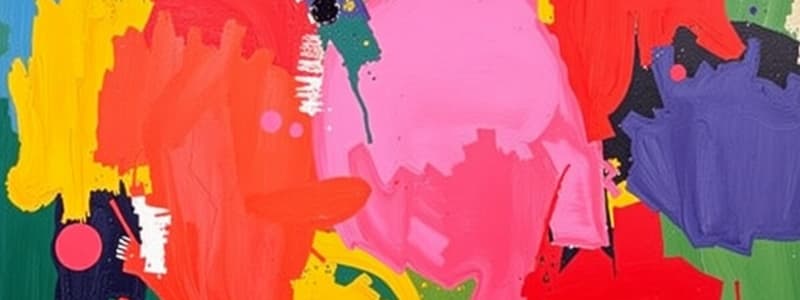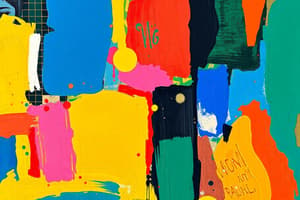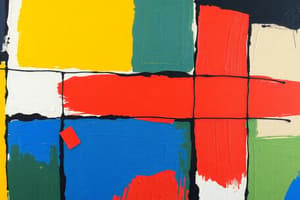Podcast
Questions and Answers
Which painter is known for his landscapes, specifically related to Filipino culture?
Which painter is known for his landscapes, specifically related to Filipino culture?
- Caravaggio
- Bong Perez
- Paul Cézanne
- Fernando Amorsolo (correct)
What type of subject does 'The Last Supper' exemplify?
What type of subject does 'The Last Supper' exemplify?
- Greek and Roman Mythology
- Still-life
- Judeo-Christian Tradition (correct)
- Seascapes
Which subject includes the portrayal of inanimate objects such as fruits and flowers?
Which subject includes the portrayal of inanimate objects such as fruits and flowers?
- Animals
- Landscapes
- Figures
- Still-life (correct)
What defines the subject of art?
What defines the subject of art?
Which event is a historical subject of artistic representation?
Which event is a historical subject of artistic representation?
Which of the following is classified as representational art?
Which of the following is classified as representational art?
Which sculpture represents Filipino mythology?
Which sculpture represents Filipino mythology?
What is a characteristic of non-representational art?
What is a characteristic of non-representational art?
Which type of art subject typically depicts scenes of Gods and heroes?
Which type of art subject typically depicts scenes of Gods and heroes?
What are seascapes, landscapes, and cityscapes primarily categorized as?
What are seascapes, landscapes, and cityscapes primarily categorized as?
When choosing a subject for an artwork, which factor is NOT mentioned as a consideration?
When choosing a subject for an artwork, which factor is NOT mentioned as a consideration?
What are the two main types of subject in art?
What are the two main types of subject in art?
Which of these artworks is associated with still-life?
Which of these artworks is associated with still-life?
Which of the following statements about subject types is true?
Which of the following statements about subject types is true?
Which artist's work is noted as an early example of non-representational art?
Which artist's work is noted as an early example of non-representational art?
Which option correctly reflects the focus of the subject in visual arts?
Which option correctly reflects the focus of the subject in visual arts?
What type of meaning pertains to the interpretation of artwork based on widely accepted motifs and symbols?
What type of meaning pertains to the interpretation of artwork based on widely accepted motifs and symbols?
Which type of meaning involves a variety of interpretations based on individual perspective?
Which type of meaning involves a variety of interpretations based on individual perspective?
What distinguishes representational art from non-representational art?
What distinguishes representational art from non-representational art?
Which of the following is an example of factual meaning in art?
Which of the following is an example of factual meaning in art?
What are common sources of subjects in artwork?
What are common sources of subjects in artwork?
Which of the following best exemplifies subjective meaning?
Which of the following best exemplifies subjective meaning?
What is often a result of confusion when encountering art?
What is often a result of confusion when encountering art?
Which of the following statements is true regarding the layers of meaning in art?
Which of the following statements is true regarding the layers of meaning in art?
Flashcards
Landscapes in art
Landscapes in art
Paintings or other artworks depicting natural scenes like mountains, forests, or bodies of water.
Still-life art
Still-life art
Art showcasing inanimate objects like fruits, flowers, or everyday items.
Figurative art
Figurative art
Art that depicts human or animal figures in varying forms and poses.
Historical art
Historical art
Signup and view all the flashcards
Mythological art
Mythological art
Signup and view all the flashcards
Seascapes
Seascapes
Signup and view all the flashcards
Cityscapes
Cityscapes
Signup and view all the flashcards
Content in art
Content in art
Signup and view all the flashcards
Subject of Art
Subject of Art
Signup and view all the flashcards
Representational Art
Representational Art
Signup and view all the flashcards
Non-Representational Art
Non-Representational Art
Signup and view all the flashcards
Subject Types
Subject Types
Signup and view all the flashcards
Representational Arts Examples
Representational Arts Examples
Signup and view all the flashcards
Non-Representational Arts Examples
Non-Representational Arts Examples
Signup and view all the flashcards
Criteria for Choosing a Subject
Criteria for Choosing a Subject
Signup and view all the flashcards
Sources of Art Subjects
Sources of Art Subjects
Signup and view all the flashcards
Factual Meaning in Art
Factual Meaning in Art
Signup and view all the flashcards
Conventional Meaning in Art
Conventional Meaning in Art
Signup and view all the flashcards
Subjective Meaning in Art
Subjective Meaning in Art
Signup and view all the flashcards
Art Subject Sources
Art Subject Sources
Signup and view all the flashcards
Art Subject Kinds
Art Subject Kinds
Signup and view all the flashcards
Art Content
Art Content
Signup and view all the flashcards
Study Notes
Module 5: Subject and Content of Art
-
Lesson Objectives: Students will differentiate subject from content, classify artworks by subject, and characterize sources and kinds of art.
-
Week Covered: Week 5
-
Learning Materials: PowerPoint Presentation, Art Appreciation textbook (Caslib, Bernardo, et al., 2018), The Humanities textbook (Zulueta, Francisco, 2013), and the course syllabus.
Subject of Art
- Definition: Subject in art is what is represented or indicated in a work of art.
- Examples: Subject in literature (an essay's subject), painting (the "what" of the painting), and other visual arts. Also, it answers "What is it all about?"
- Variety: The subject of art can vary.
Subject Types
- Representational/Objective Art: Artworks that depict recognizable subjects (people, objects, scenes, events). Examples include paintings, sculptures, graphic arts, literature, and theater.
- Non-Representational/Non-Objective Art: Artworks that do not depict recognizable subject matter. Examples include music, architecture, and some abstract art. (e.g., Delaunay's work).
Criteria for Choosing a Subject
- Artist's Freedom: Artists are free to choose their subject.
- Personal Interest: The subject should relate to the artist's personal interests.
- Availability of Medium and Patronage: Artists need to consider the resources available (medium) and support they might receive (patronage).
Sources of Art Subjects
- Nature: Landscapes, seascapes, cityscapes, and still lifes (inanimate objects like cups, glasses, bottles, flowers).
- History: Events from the past (e.g., Ang Gerilya - UP Students, Landing Memorial of General Douglas MacArthur).
- Mythology: Greek and Roman mythology, and other mythological subjects.
- Judeo-Christian Tradition: Subjects from the Bible (e.g., The Last Supper).
- Sacred Oriental Texts: Subjects from religious texts like the Quran, Bible, Vedas.
- Animals: Portraits of animals.
- Figures Portraits of humans.
- Seascapes, Landscapes, Cityscapes Visual portrayal of exterior sights.
- Mythology Stories and figures from mythologies (e.g., The Twelve Olympians).
Content in Art
- Meaning Levels: Content in art signifies the deeper meaning or message conveyed in an artwork. It describes the artwork itself, and can be Factual, Conventional, or Subjective.
- Factual: The basic, literal depiction of the artwork.
- Conventional: The widely accepted or understood meaning of motifs, symbols, and signs within the work.
- Subjective: The individual meaning or interpretation of the viewer.
- Sources of Content: Content includes nature, history, Greek/Roman Mythology, and more. Visual elements like figures, scenes, animals, myths, or mythology are examples.
Additional Information
- Analysis of Artwork: Students are asked to analyze different artworks, identifying type, sources, and kinds of subjects.
- Quiz: A quiz on evaluating art content (factual, conventional, subjective meaning) is included; questions about specific artworks might be asked
- Output Activity: Students are required to create an artwork, illustrating the representational subject and content. They also need to describe their artwork in a short narration.
Studying That Suits You
Use AI to generate personalized quizzes and flashcards to suit your learning preferences.




